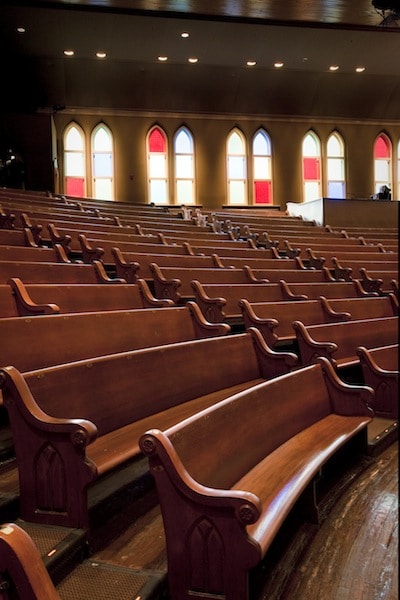
Videos by American Songwriter
KICKING UP SOME HILLBILLY DUST
“Is it wonderful to sit out there? Is this a great place to feel the hillbilly dust?” Emmylou Harris asks her audience after serenading them with a cover of “Half As Much,” a hit for Hank Williams in 1952. The “great place” she’s referring to is the Ryman, where she played a three-night stand in 1991 to a small but excitable audience of about 600 people. She’s backed by her band the Nash Ramblers, which included Sam Bush and Roy Huskey Jr., and together they ramble through old classics like Cowboy Jack Clement’s “Guess Things Happen That Way” and new hits like Steve Earle’s “Guitar Town.” Rather than solemn or somber, her performance is loose and giddy – more hootenanny than hymn.
Her concerts – along with the 1992 live album they produced, At The Ryman – brought new attention to the building and today are credited with saving it from demolition. It’s impossible to believe a structure as storied and meaningful as the Ryman might be threatened with a bulldozer, but country music had changed dramatically in the twenty years since the Opry had moved out east of town. The songwriting industry had splintered into innumerable scribes and publishers, pluggers and producers; occasionally a throwback album like 1987’s Trio – by Harris, Dolly Parton, and Linda Ronstadt – would find its way onto the charts, but for better or for worse the industry was looking ahead to the future, not back to the past.
Old stars like Cash floundered, others were forgotten, and the Ryman fell into neglect. “At the time it was just a tourist destination,” says Marty Stuart. “For two dollars, you could walk around, have your picture taken on the stage. There were birds flying around the place. It was in almost total disrepair.” A campaign to revitalize the building began in the late 1980s, and Stuart credits E.W. “Bud” Wendell, president of the Gaylord Entertainment Company, which had purchased the Ryman along with the Grand Ole Opry. “Bud had a passion for the place. He saw the history in it and felt it needed to be preserved.”
Those efforts culminated, in some ways, in Harris’s live album. “Emmylou’s show didn’t bring in many people, but it did bring attention to the Ryman,” says Colladay. “It was released on CD and video and was broadcast on TNN. Her fans tend to be fans of traditional music, so her show presented the Ryman to a new generation of fans who maybe had heard about it but hadn’t really experienced it. It just stimulated interest in bringing that place back to life.”
At The Rymancovered the spectrum of roots music, setting the tone for the folk revival of the 2000s. As she had done throughout her long career, Harris took liberties with country music, marrying it to rock, bluegrass, folk, and blues. In much the same way, the Ryman has grown to become more than just the “mother church of country music.” Rather, it has become a temple to American folk traditions, encapsulating almost every genre and subgenre. Today, the venue hosts shows by artists as diverse as Beck, Yonder Mountain String Band, Wilco, even stars of the ABC series Nashville. Earlier this year, the folk rock group Band of Horses released their own acoustic Live At The Ryman.
Today, the Ryman has become the receptacle for local history, a focal point for preserving, studying, understanding, and even reviving the past. Fans of traditional music decry Nashville’s neglect of its own legacy, but at least commercially, the Acuff-Rose template remains entrenched in the industry, an intangible throwback to the good old days. And the rise of writer-performers like Ashley Monroe, Brandy Clark, and Kacey Musgraves suggests that the song remains as central as ever within the industry. “We have an incredible foundation in Nashville,” says Stuart. “It doesn’t matter what happens in popular culture, because we have some deeply rooted traditions that hold us steady. But country music has always evolved and will continue to evolve, because every song that is written propels it to a different place. It’s a creative town, so we’re always in a state of change.” The Ryman has become the place against which that change can be measured.
This article appears in our July/August 2014 issue. Buy it here or download it here. Or better yet, subscribe.

One Comment
Leave a Reply